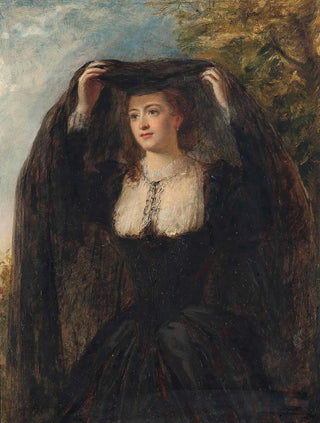Art print | The Veil - William Powell Frith


View from behind

Frame (optional)
In the fascinating world of Victorian art, few works manage to capture the essence of the society of the time with as much finesse as "The Veil" by William Powell Frith. This canvas, both narrative and visual, immerses us in a moment of life, a scene where human interactions blend with meticulously crafted details. Frith, a master of realism, succeeds here in evoking deep emotions while offering a reflection on the social norms of the 19th century. The delicacy of the subject, combined with the richness of colors and the precision of strokes, makes this artwork a true masterpiece that continues to pique the interest of art enthusiasts.
Style and uniqueness of the work
"The Veil" stands out for its realistic approach, an emblematic feature of Frith's work. The artist uses compositional elements that attract the eye and tell a story. Each character is carefully positioned, creating a visual dynamic that invites the viewer to engage with the scene. The play of light and shadow adds unprecedented depth, while the clothing details reveal the attention to detail and meticulousness that characterize Frith's style. The facial expressions, both subtle and evocative, demonstrate the artist's ability to capture the human soul. In sum, "The Veil" is a work that transcends mere decoration to become a true study of the human condition.
The artist and his influence
William Powell Frith, born in 1819, is one of the most influential painters of his time. His work is marked by a deep commitment to realism, an approach that aims to depict everyday life with striking accuracy. Frith also distinguished himself by his ability to incorporate narrative elements into his compositions, thus offering an additional dimension to his paintings. His influence extends beyond his era, inspiring many contemporary and future artists who sought to capture life from an authentic perspective. By exploring social and cultural themes, Frith contributed to shaping the perception of art as a mirror of society, a legacy that endures to this day.
A wall decoration

Matte finish

View from behind

Frame (optional)
In the fascinating world of Victorian art, few works manage to capture the essence of the society of the time with as much finesse as "The Veil" by William Powell Frith. This canvas, both narrative and visual, immerses us in a moment of life, a scene where human interactions blend with meticulously crafted details. Frith, a master of realism, succeeds here in evoking deep emotions while offering a reflection on the social norms of the 19th century. The delicacy of the subject, combined with the richness of colors and the precision of strokes, makes this artwork a true masterpiece that continues to pique the interest of art enthusiasts.
Style and uniqueness of the work
"The Veil" stands out for its realistic approach, an emblematic feature of Frith's work. The artist uses compositional elements that attract the eye and tell a story. Each character is carefully positioned, creating a visual dynamic that invites the viewer to engage with the scene. The play of light and shadow adds unprecedented depth, while the clothing details reveal the attention to detail and meticulousness that characterize Frith's style. The facial expressions, both subtle and evocative, demonstrate the artist's ability to capture the human soul. In sum, "The Veil" is a work that transcends mere decoration to become a true study of the human condition.
The artist and his influence
William Powell Frith, born in 1819, is one of the most influential painters of his time. His work is marked by a deep commitment to realism, an approach that aims to depict everyday life with striking accuracy. Frith also distinguished himself by his ability to incorporate narrative elements into his compositions, thus offering an additional dimension to his paintings. His influence extends beyond his era, inspiring many contemporary and future artists who sought to capture life from an authentic perspective. By exploring social and cultural themes, Frith contributed to shaping the perception of art as a mirror of society, a legacy that endures to this day.
A wall decoration






